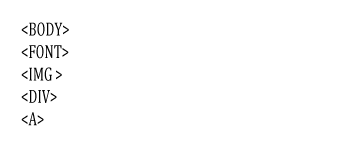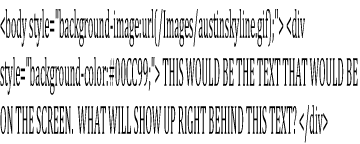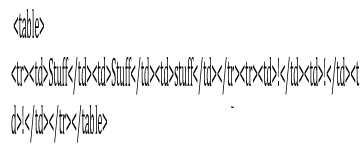Digital Media Literacy. Second Trimester Final
(207).webp)
This final will show how well each student understands the HTML code they have been working with.
- 1.
What element of a style sheet will cause text to wrap around an image on the left or right?
- A.
Explanation
The element of a style sheet that will cause text to wrap around an image on the left or right is the "float" property. When an image is set to float left or float right, the text will flow around it, creating a wrapping effect. This allows for a more visually appealing layout, with the image integrated seamlessly within the text content.Rate this question:
-
- 2.
Which tags shown here require a footer?
- A.
The body tag
- B.
The font tag
- C.
Only the font tag and the div tag
- D.
None of them
- E.
All of the tags require a footer
Correct Answer
E. All of the tags require a footerExplanation
All of the tags require a footer because a footer is a section that typically contains information about the author, copyright details, contact information, or other relevant information at the bottom of a webpage. Since all of the mentioned tags (body, font, and div) are used to structure and format the content of a webpage, it is common practice to include a footer to provide additional information or navigation options for the users.Rate this question:
-
- 3.
Which tags shown here can have an inline style sheet?
- A.
Font only
- B.
Div tags only
- C.
Hyperlinks only
- D.
Body, font and div only
- E.
All of the tags can use inline style sheets
Correct Answer
E. All of the tags can use inline style sheetsExplanation
All of the tags mentioned in the options can have an inline style sheet. Inline style sheets are applied directly to individual HTML elements using the "style" attribute. This allows for the customization of the appearance of the element, including font, color, size, etc. Therefore, all the mentioned tags (font, div, hyperlinks, body) can use inline style sheets to apply specific styles to them.Rate this question:
-
- 4.
3. IF YOU WANTED TO POSITION A GRApHIC OR TABLE ON A PAGE WHAT THREE ELEMENTS WOULD YOU NEED IN A STYLE SHEET TO PUT IT IN IT’S PROPER PLACE?
- A.
Relative, bottom, right
- B.
Position, top, left
- C.
Inherit, center, absolute
- D.
Place, where, src
- E.
Z-index, pic, position
Correct Answer
B. Position, top, leftExplanation
To position a graphic or table on a page, you would need to use the CSS properties position, top, and left in a style sheet. The position property determines the type of positioning method used for the element, such as relative or absolute. The top property specifies the distance from the top edge of the containing element to the top edge of the positioned element. The left property specifies the distance from the left edge of the containing element to the left edge of the positioned element. By using these three elements in a style sheet, you can place the graphic or table in its proper place on the page.Rate this question:
-
- 5.
4. WHICH Z-INDEX WILL BE ON THE BOTTOM OF THE LAYERS?
- A.
Z-index: 2
- B.
Z-index: 0
- C.
Z-index: -5
- D.
Z-index:5
- E.
Z-index: b
Correct Answer
C. Z-index: -5Explanation
The z-index property determines the stacking order of elements on a webpage. A higher z-index value means the element will be placed on top of elements with lower values. In this case, the z-index value of -5 indicates that the element will be placed at the bottom of the layers, below elements with positive z-index values.Rate this question:
-
- 6.
TRUE OR FALSE: the image hyper link below is properly formatted.
- A.
True
- B.
False
Correct Answer
B. FalseExplanation
The given answer is False because there is no image hyperlink provided in the question. Since there is no image hyperlink mentioned, it cannot be determined whether it is properly formatted or not. Therefore, the answer is False.Rate this question:
-
- 7.
IN THE CODE ABOVE WHAT SIZE and color WILL THE FONT BE WHEN IT IS SHOWN in the browser?
- A.
Font 5 and color blue
- B.
Font 6 and color white
- C.
Font 11 and color black
- D.
Font 12 and color white
- E.
Font 5 and color black
Correct Answer
D. Font 12 and color whiteExplanation
The font size and color that will be shown in the browser is font 12 and color white. This can be determined by analyzing the given options and selecting the one that matches the answer.Rate this question:
-
- 8.
What is wrong with this hyper link and why won’t it work?
- A.
Nothing's wrong it works just fine
- B.
The web address does not have quotes around it
- C.
No footer is needed and the text is in the wrong place
- D.
There is no 'A' anchor tag used and the quotes are missing around the address
- E.
Href is the wrong tag for a hyperlink and will not be visible in a browser.
Correct Answer
D. There is no 'A' anchor tag used and the quotes are missing around the addressExplanation
The given correct answer states that the hyperlink is not working because there is no 'A' anchor tag used and the quotes are missing around the address. In HTML, the 'A' tag is used to create hyperlinks, and the 'href' attribute within the 'A' tag specifies the destination of the link. Additionally, the web address should be enclosed in quotes to indicate that it is a string value. Therefore, without the 'A' tag and the missing quotes, the hyperlink will not work properly.Rate this question:
-
- 9.
True or false? The body tag can set all attributes for the entire page including margins and text color.
- A.
True
- B.
False
Correct Answer
A. TrueExplanation
The body tag in HTML can indeed set various attributes for the entire page, including margins and text color. This tag is used to define the main content of the HTML document and acts as a container for all the visible elements on the page. By applying CSS properties to the body tag, such as margin and color, the appearance of the entire page can be modified uniformly. Therefore, the statement "The body tag can set all attributes for the entire page including margins and text color" is true.Rate this question:
-
- 10.
in the code below: will the image or the color be showing for the background behind the text?
- A.
Only the image
- B.
Only the color
- C.
The color will show behind the words but the background can be seen
- D.
Neither it is coded incorrectly
- E.
The background will be in front of the color
Correct Answer
C. The color will show behind the words but the background can be seenExplanation
The correct answer suggests that the color will be displayed behind the words, but the background image will still be visible. This means that the background color will act as a base for the text, but the background image will still be seen as it is not completely covered by the text.Rate this question:
-
- 11.
All graphic types below can be viewed on a web page except: *.jpg, *.gif, *.psd, *.bmp.
- A.
PSD
- B.
BMP
- C.
GIF
- D.
JPG
Correct Answer
A. PSDExplanation
PSD files are not typically viewable on a web page because they are native to Adobe Photoshop and contain layers and other editable elements that cannot be displayed directly in a web browser. On the other hand, JPG, GIF, and BMP are common image file formats that can be easily viewed on a web page.Rate this question:
-
- 12.
TRUE OR FALSE: you can view your live web page without uploading it to the server.
- A.
TRUE
- B.
FALSE
Correct Answer
B. FALSEExplanation
It is not possible to view a live web page without uploading it to a server. In order for a web page to be accessible on the internet, it needs to be hosted on a server and made available for users to access through their web browsers. Without uploading the web page to a server, it would only exist locally on a computer and wouldn't be accessible to others on the internet.Rate this question:
-
- 13.
TRUE OR FALSE: all content, that will be viewed on a live web page, must be between the body header and footer tags.
- A.
TRUE
- B.
FALSE
Correct Answer
A. TRUEExplanation
All content that will be viewed on a live web page must be placed between the body header and footer tags. This is because the body tags define the main content area of a web page, where all the visible elements such as text, images, and videos are placed. The header and footer tags are used to define the top and bottom sections of the page, respectively, and typically contain navigation menus, logos, copyright information, etc. Therefore, any content that needs to be displayed on the webpage must be placed within the body tags.Rate this question:
-
- 14.
How many columns and rows will be generated with the code below?
- A.
2 columns 6 rows
- B.
3 columns 2 rows
- C.
6 rows 2 columns
- D.
3 rows 3 columns
- E.
2 columns 3 rows
Correct Answer
B. 3 columns 2 rowsExplanation
The code will generate a table with 3 columns and 2 rows. This can be inferred from the given options, where the correct answer is "3 columns 2 rows".Rate this question:
-
- 15.
TRUE OR FALSE: a table cannot be used to divide a page into sections.
- A.
TRUE
- B.
FALSE
Correct Answer
B. FALSEExplanation
A table can be used to divide a page into sections. Tables can be used to organize content into rows and columns, which can help in creating distinct sections on a page. Each row in the table can represent a different section, and the columns can be used to arrange the content within each section. Therefore, the statement that a table cannot be used to divide a page into sections is false.Rate this question:
-
Quiz Review Timeline +
Our quizzes are rigorously reviewed, monitored and continuously updated by our expert board to maintain accuracy, relevance, and timeliness.
-
Current Version
-
Feb 07, 2024Quiz Edited by
ProProfs Editorial Team -
Feb 26, 2009Quiz Created by
Tyeron Hammontree
 Back to top
Back to top









